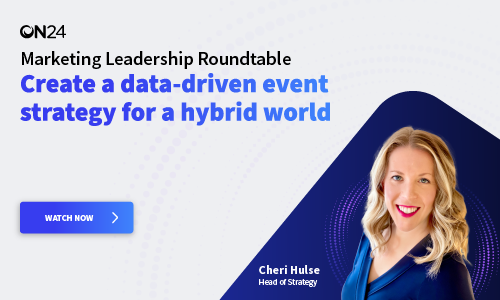When Should You Use a Hybrid Event? 5 Scenarios to Consider

The B2B marketing world is abuzz with hybrid events, a new event format promising to meld together the best elements of physical and virtual events. When conducted well, hybrid events can extend the reach of an event, enhance a brand’s messaging and collect a wealth of audience insights that can help accelerate a buying journey.
But if a hybrid event is done poorly – for example, simply streaming an in-person event to a virtual audience – companies risk missing out on key buying signals and, in the worst case, damaging their brand.
The key to a successful hybrid event strategy is knowing when, where and why to deploy the event type. Event marketers will need to start training new muscles and identify when hybrid is a reasonable option to enhance an event’s goals, whether those goals are to reach more people, extend the reach of your event across geographies, add value to sponsorship or more.
Use Hybrid Events When You Want To:
1. Increase the reach of an event
2. Deliver a large scale event across multiple geographies
3. Extend the life of an event
4. Are running training or enablement events
5. Offer more value and reach to sponsors
First, What Even Is a Hybrid Event?
But first, let’s answer a key question: what exactly is a hybrid event?
It’s A Complete Experience for Both Digital and Physical Audiences

A hybrid event provides every attendee – regardless of whether they are present physically or digitally – with a full, unique and engaging event experience. For event marketers, this means creating an integrated program sharing messaging, branding, event content and resources, speakers and more.
Keep in mind that a physical or virtual attendee doesn’t have to share the same experience (it’d make for an awkward experience to live stream a happy hour, for example), but two elements should hit the same beats. For example, if you’re hosting a happy hour event for your in-person attendees, consider throwing a mixology class or virtual happy hour for your virtual participants.
The point is that every attendee should walk away from your live event fully engaged – whether they attended in person or online – and satisfied with the overall experience.
Okay, so we covered what a hybrid event is. But what isn’t a hybrid experience when nearly everything has a digital element today?
What a Hybrid Event Is Not

That’s an easy question to answer: a hybrid event is never a live stream of a physical event. Simple live streams lack interaction and give what could be half (or more) of your live audience a second-class experience. If you’re producing a live stream of your event, then you’re simply doing that: creating a live stream of your event.
Why this distinction? Because the strength of hybrid events comes from the ability to engage with audiences wherever they are. This means being able to interact equally with both your in-person and virtual attendees. It means being able to deliver event content, run polls, have Q&A sessions, 1on1 sales conversations, peer-to-peer networking and, overall, engaging both a physical or virtual audience on similar terms.
Crucially, a passive live stream denies you the essential benefit of a hybrid event: data. That’s because stellar, engaging virtual experiences encourage an active audience that will download resources, ask speakers questions, and participate in breakout rooms. True hybrid events empower you to see your audience’s digital body language. Live streams are just that: live streams.
Which brings us to our next point…
5 Times You Should Consider Running a Hybrid Event

Okay, now for the million-dollar question: when should you use a hybrid event?
The simple answer is that you should use a hybrid event when you have a strategy to provide both virtual and physical audiences with an engaging event experience. But that’s a bit like saying you should only start painting when you’ve successfully reproduced a Van Gogh.
So, when should you run a hybrid event? Let’s take a look at five scenarios:
1. When you want to increase the reach of an event
Hybrid events are a great solution for extending the reach of a live event. They help you to involve your extended community, include top-of-funnel prospects and can provide a virtual participant with a budget and/or travel friendly means of participating.
2. When you want to deliver a large event across multiple geographies
Running an onsite event alone limits your brand’s reach – even if it’s a massive user conference. A hybrid approach changes this dynamic and allows you to scale your event anywhere.
This is especially important in an era where the funds for travel (not to mention the willingness to travel in the first place) isn’t a guarantee.
And being able to scale dynamically can also be helpful when you want to target (or are running events in) specific regions and geographies. If you’re running an in-person roadshow, for example, you can use your virtual event platform to target and connect with a digital audience in the same region – you can even provide them with a free lunch to get the full experience.
3. When you want to extend the life of an event
Events have a predictable shelf-life. You promote them, run them, then end them over the course of weeks or months, depending on the size of the event. Hybrid, however, changes this dynamic.
Not only can you hold pre-event events (like live thought leader panels before your big day), but you can extend the life of your event by adding a digital component.
To truly extend the life of your event – and the virtual content that’s come out of it – plan to record, re-mix and re-purpose sessions, keynotes, panels and more. Doing so empowers you to integrate your event takeaways and messages into additional campaigns, e-books and other subsequent events.
4. When you are running training or enablement events
Internal training and enablement events are essential, but not everyone is able to attend a one-off event. Sales reps can be in the field. Marketers can have conflicts. And, of course, regional teams may be off-hours.
An internal hybrid event solves this problem by empowering remote teams to tune in and participate in the training no matter where they are or when they’re watching.
That’s because with an internal hybrid event, a remote attendee can still participate by asking questions (which can be followed up over email, if they’re watching on-demand), downloading resources and watching the same presentation or training as their in-person peers.
5. When you want to offer more value and reach to sponsors
Hybrid events are also a great way to incentivize sponsors. That’s because hybrid events provide brands with two unique opportunities: first, the ability to brand a dedicated digital environment; second, the ability to measure engagement and immediately identify promising leads.
Providing sponsors with branded digital properties and direct audience engagement is a huge value add. Both empower sponsors to directly interact with audiences (whether through virtual booths, networking sessions and chats) and provides them with on-demand resources that can be used as follow-up collateral for physical attendees.
When You Should Not Use a Hybrid Event

Okay, so we now know when you should consider running a hybrid event. But what about when you should avoid one? After all, it’s very easy and very tempting to set up a webcam for live streaming and call it a day.
The decision is not always clear. But bear in mind: if you decide a hybrid event isn’t right for your goals, that doesn’t mean you need to go all-in on a physical gathering. In fact, you may see more success with an all-digital approach.
Let’s run through two scenarios when a hybrid event would be an inappropriate use of time and resources.
When You Cannot Provide an Equal Experience for All Attendees
First and foremost, avoid running a hybrid event when you know you cannot provide an equally engaging experience for attendees. For example, if virtual attendees cannot interact, cannot engage and are generally treated as an afterthought, then going all-in on physical tactics may be a more appropriate approach.
There are also times when – by its nature – an analog-only approach is suitable. These examples can include small networking events and white-glove experiences where you need to pull out all the stops to impress critical accounts.
When You Need an Experience Fast
Hybrid events are not a great tactic to fall back on at the last minute. They take a lot of planning and a lot of coordination to pull off right – and if you don’t plan, you risk alienating your virtual audience.
If you need an event fast, go digital.
Start by analyzing what your goal is. If you need to generate pipeline to meet quarterly goals, then spinning up a virtual event, like a webinar, is a viable option. Don’t forget to include partners! They’re often great resources for panelists and joint promotion.
When you don’t want to add to the expense/travel restrictions of hybrid/in-person event
Let’s face it: for many, travel to a live event is tedious, uncomfortable and sometimes expensive. That’s not to mention potential travel restrictions given health conditions around the globe.
A hybrid approach makes life easier for these would-be physical attendees by providing a virtual component, allowing them to attend a session from the comfort of their office (or home) and while enjoying the same insights and networking opportunities.
Start Planning Your Hybrid Strategy Today
Hybrid events will be a crucial part of any marketing mix well into the future. Sit down and work with your sales and marketing teams to identify the most suitable use of hybrid for your audience.
Remember: the key objective of a hybrid event is creating an amazing experience regardless of whether an audience member attends in person or online. Just make sure you keep both your physical and digital audiences in mind while you plan and create content.
A good rule of thumb? Make sure it’s an experience, regardless of whether you attend physically or digitally, you’ll want to attend yourself. Good luck!

